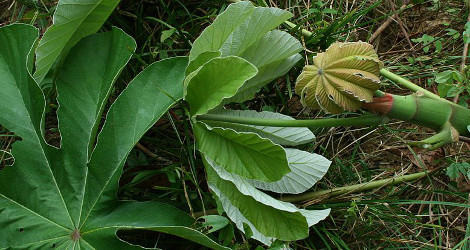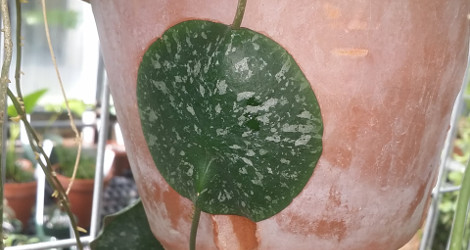SPECIAL COLLECTION:
Ant Plants (myrmecophytes)
Certain species of ferns, particularly in the genus Lecanopteris, have specialized flattened rhizomes which provide shelter for ant colonies - some of these rhizomes can be hollowed out as well. The potato fern, Solanopteris brunei, has distinct dimorphic rhizomes with drastically modified 'potato-like' tubers readily utilized by ants.
Some neotropical Vachellia species (Ant-Acacias) have hollowed out thorns which are inhabited by ants and the ascidiate (hollow, pitcher-like) leaves of Dischidia are frequently used as domiciles by ants. The leaves of some plants, including many in the Rubiaceae such as Coffee, have less pronounced adaptations, merely dimples in the leaf surface which provide a protected area for ants to live.
Some plants produce specialized food structures to encourage the settling of an ant colony. Many of the same Vachellia species that have hollowed out thorns also bear tiny yellow detachable leaf tips called Beltian Bodies which are high in both fat and protein and serve as an important ant food source. Pearl bodies and Beccarian bodies are high fat food sources found on the leaves of such plants as Balsa Wood, old world Macaranga plants and numerous species in the grape family. Mullerian bodies, found on the petioles of neotropical Cecropia trees, are rich in glycogen, an important carbohydrate source in animals that is rarely found in plants. The petioles of Cecropia are also hollow, which provides an ideal ant domicile.Species of plants in many families from around the world produce extra-floral nectaries - nectar producing plant parts found outside of the flowers in leaves, stems and twigs. While nectar sources from flowers may be distinctly seasonal in availability, most plants with extra-floral nectaries produce them year-round, thus ensuring the benefits of the symbioses outside of the flowering season. Having extra-floral nectaries may also serve as a distraction from floral nectaries, where ants and other crawling insects could interfere with proper pollination of the flowers. In most cases, harvesting of nectar from extrafloral nectaries is not specific to any one insect group, but ants make very good use of these food sources when available and will often defend such 'prime territory' thus benefiting the plants.
Some plants are frequently found growing exclusively in ant-nests, or piles of detritus left behind by ants as they forage and build their nests. This decaying matter provides a nutrient rich media for plants, particularly those living epiphytically in the rainforest canopy. The tropical Cecropia tree apparently gains over 90% of its nitrogen needs from decaying ant waste.Finally, dispersal of some seeds can be facilitated by the presence of fat containing elaiosomes on the seeds, which encourages ants, as well as other insects, to harvest the seeds and carry them off where, hopefully, some of them will fall by the wayside to serve as propagules for the parent plant.
An excellent article on the cultivation of selected epiphytic ant-plants appeared in the 2000 Cactus and Succulent Journal1
References:
- Plummer, N., Cultivation of the epiphytic ant-plants Hydnophytum and Myrmecodia, Cactus and Succulent Journal 72:142-147 (2000)
- UCLA Botanic Garden - defunct website
- Wikipedia
- Solanopteris brunei, a Little-Known Fern Epiphyte with Dimorphic Stems, W. H. Wagner, Jr. American Fern Journal Vol. 62, No. 2 (Apr. - Jun., 1972), pp. 33-43, Published by: American Fern Society, Article Stable URL: http://www.jstor.org/stable/1546036
Greenhouse Locator Map:

data regenerated on Wed, 09 Jul 2025 02:13:38 -0400
42 Accessions:
Number in parentheses references locator map icons
- {0} Hydnophytum formicarum 'Europa' - 'Europa' form - Rubiaceae

- {1} Cecropia peltata - Trumpet Tree, Snakewood Tree - Urticaceae


- {2} Hoya imbricata - Apocynaceae

- {3} Hydnophytum aff. moseleyanum - Rubiaceae


- {3} Hydnophytum papuanum - Rubiaceae


- {3} Hydnophytum puffii - Rubiaceae



- {3} Hydnophytum ramispinum - Rubiaceae



- {3} Hydnophytum simplex - Rubiaceae


- {3} Myrmecodia beccarii - Rubiaceae



- {3} Myrmecodia platytyrea ssp. antoinii - Rubiaceae

- {3} Myrmecodia sp. - pink fruited species - Rubiaceae


- {3} Myrmecodia tuberosa 'armata' - Ant Plant - Rubiaceae


- {3} Myrmecodia tuberosa 'dahlii' - Rubiaceae


- {4} Dischidia major - Malayan Urn Vine - Apocynaceae


- {4} Hoya imbricata - Apocynaceae

- {5} Piper cenocladum - Ant Piper - Piperaceae


- {6} Vachellia cornigera - Bull-thorn Acacia - Fabaceae


- {6} Vachellia hindsii - Iscanal Negro, Ant Acacia - Fabaceae


- {7} Lecanopteris luzonensis - Ant Fern - Polypodiaceae

- {8} Myrmecophila tibicinis - Fluteplayer's Schomburgkia - Orchidaceae



- {9} Hydnophytum formicarum - Rubiaceae


- {10} Aechmea brevicollis - Short Necked Bromeliad - Bromeliaceae


- {11} Tillandsia bulbosa - Dancing Bulb - Bromeliaceae


- {12} Tillandsia baileyi - Bromeliaceae

- {13} Tetrastigma voinierianum - Chestnut Vine - Vitaceae


- {14} Hydnophytum formicarum - Horne form - Rubiaceae



- {14} Hydnophytum formicarum - Pumpkin form - Rubiaceae


 W/C
W/C - {14} Hydnophytum longistylum - Rubiaceae

 W/C
W/C - {14} Hydnophytum sp. - Shoe Caudex Form - Rubiaceae W/C
- {14} Myrmecodia platytyrea - Ant Plant - Rubiaceae



- {14} Myrmecodia platytyrea - Mossman, Australia form - Rubiaceae


- {14} Myrmephytum beccarii - Rubiaceae


- {14} Myrmephytum cf. selebicum - Rubiaceae


- {14} Squamellaria guppyana - Rubiaceae

- {15} Hydnophytum moseleyanum - Hydnophytum, Ant Plant - Rubiaceae



- {15} Hydnophytum moseleyanum - Ant Plant - Rubiaceae


 W/C
W/C - {15} Myrmecodia sp. - Rubiaceae


- {15} Myrmecodia tuberosa - Ant Plant - Rubiaceae



- {15} Pachycentria glauca - Pachycentria - Melastomataceae

- {0} Hydnophytum orichalcum - Rubiaceae

- {0} Myrmecodia sp. - Rubiaceae


- {0} Platycerium madagascariense - Polypodiaceae
W/C = Wild Collected
 = Currently Flowering
= Currently Flowering = Image(s) Available
= Image(s) Available = map available for this accession
= map available for this accession
 = voucher(s) on file at CONN for this accession
= voucher(s) on file at CONN for this accession = accession added within past 90 days
= accession added within past 90 days















